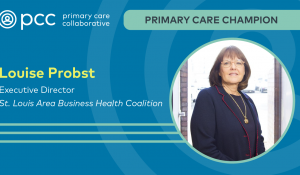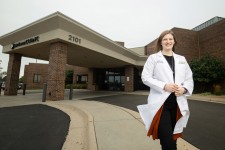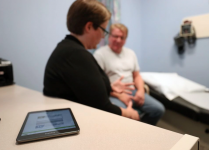News Room
January 8, 2020 | Health Affairs Blog
Millions of Americans are receiving medical treatments, tests, and procedures that are either wasteful or ineffective every single year. These services, dubbed as “low-value health care,” are defined as services for which the potential for...
December 17, 2019 | U.S. News & World Report
The number of Americans who have a primary care doctor is shrinking -- with potential consequences for their health, researchers say.
Their new study found that in 2015, an estimated 75% of Americans had a primary care provider -- down...
December 16, 2019 | Colorado Department of Regulatory Agencies
The Colorado Primary Care Payment Reform Collaboraitve just published its first recommendations report. This report will guide Colorado in its primary care reform attempts throughout the year of 2020 and contains detailed information on...
December 13, 2019 | JAMA Network
A new study from the Health Care Cost Institute study show slightly declining rates of primary care spending as a share of total spending. The research letter, published December 10th in JAMA, analyzed employer-sponsored insurance data...
December 10, 2019 | Washington Post
Physician Emilie Scott was only a few months into her first job when she started hearing the complaint: She was spending too much time with each patient.
Like many primary care doctors working in large medical systems, Scott was...
December 10, 2019 | Kaiser Health News
There’s a new question that anti-hunger advocates want doctors and nurses to ask patients: Do you have enough food?
Public health officials say the answer often is “not really.” So clinics and hospitals have begun stocking their own food...
December 10, 2019
The Issue
A strong primary care system can help prevent illness, manage patient care across multiple providers, and reduce health care costs. Essential to such a system is effective communication. To address patients’ needs, primary care...
November 26, 2019 | Health Affairs Blog
Health care systems are being flooded with a slew of digital innovations, both internally and externally sourced. The promise of remote sensors, machine learning, artificial intelligence, and personal health records, together with...
November 25, 2019 | Modern Healthcare
The CMS on Monday announced that it's accepting applications for its direct contracting alternative payment model.
The pilot will allow providers that deliver evaluation and management services to take on financial risk for original, fee-...
November 7, 2019 | Health Affairs Blog
Nearly 78 million people live in the 7,500-plus areas designated as primary care health professional shortage areas by the Department of Health and Human Services (as of November 2019). Approximately 65 percent of these shortage areas are...
November 4, 2019
The Patient-Centered Primary Care Collaborative, a leading health care advocacy organization, is now the Primary Care Collaborative (PCC).
The logo suggests an individual at the center of cascading circles, reflecting PCC’s ongoing...
November 4, 2019 | PCPCC Press Release
FOR IMMEDIATE RELEASE
Monday, November 4, 2019
Washington, D.C. – The Patient-Centered Primary Care Collaborative, a leading health care advocacy organization, has changed its name to the Primary Care Collaborative (PCC). The...
October 24, 2019 | Health Affairs Blog
Addressing our country’s mental health crisis will require a multipronged approach over many years. Steps are being made at every level of government: States are beginning to strengthen and enforce insurance protections for mental health...
October 21, 2019 | Health Affairs Blog
In December 2018, the Centers for Medicare and Medicaid Services (CMS) announced a major overhaul of the Medicare Shared Savings Program (MSSP) by finalizing Pathways to Success. This was one of the largest changes to the Medicare ACO...
October 18, 2019 | Kaiser Family Foundation
Medicaid covers one in five Americans, accounts for one in six dollars spent on health care in the United States, and makes up more than half of all spending on long-term services and supports.1 Medicaid is a state budget driver as well as...
October 15, 2019 | Health Affairs Blog
The recent Health Affairs article by Irene Papanicolas and colleagues entitled “The Relationship Between Health Spending And Social Spending In High-Income Countries: How Does The US Compare?” provides new and important data on the...
October 9, 2019 | Kaiser Health News
SALINA, Kan. — The University of Kansas School of Medicine-Salina opened in 2011 — a one-building campus in the heart of wheat country dedicated to producing the rural doctors the country needs.
Now, eight years later, the school’s first...
October 8, 2019 | The Boston Globe
REVERE — Dr. Amy Wheeler set a small tablet computer on the table as she turned to face her patient. Then she did something that’s become increasingly rare for doctors in the digital age: She talked to him without typing or clicking...
October 8, 2019 | Health Affairs Blog
The numbers get our attention: More than 10,000 baby boomers turn 65 every day, with the 80-and-older segment growing the fastest and more likely to be homebound or home-limited; the number of people ages 65 and older will more than double...
October 1, 2019 | Health Affairs Blog
On September 30, 2019, the Department of Health and Human Services (HHS) released a bulletin outlining a new opportunity for 10 states to participate in a wellness demonstration project in the individual market. HHS will begin accepting...
Pages
Recent Newsletters
April 1, 2022
December 20, 2021
September 30, 2021
June 30, 2021
March 30, 2021
"And as with the Sustainable Growth Rate (SGR) of the past, the resulting perennial payment uncertainty will hamper… https://t.co/Cb49dORgRs —
1 year 6 months ago
Statement by @AnnGreiner1 , President and CEO of the Primary Care Collaborative, Regarding #Congress’ Reported Fail… https://t.co/bhITRc9jNr —
1 year 6 months ago
“Despite purporting to ‘fund the government,’ Congress now seems ready to defund every #primarycare practice servin… https://t.co/GlM6p2RcAN —
1 year 6 months ago
Secondary menu
Copyright © 2024 Primary Care Collaborative




















